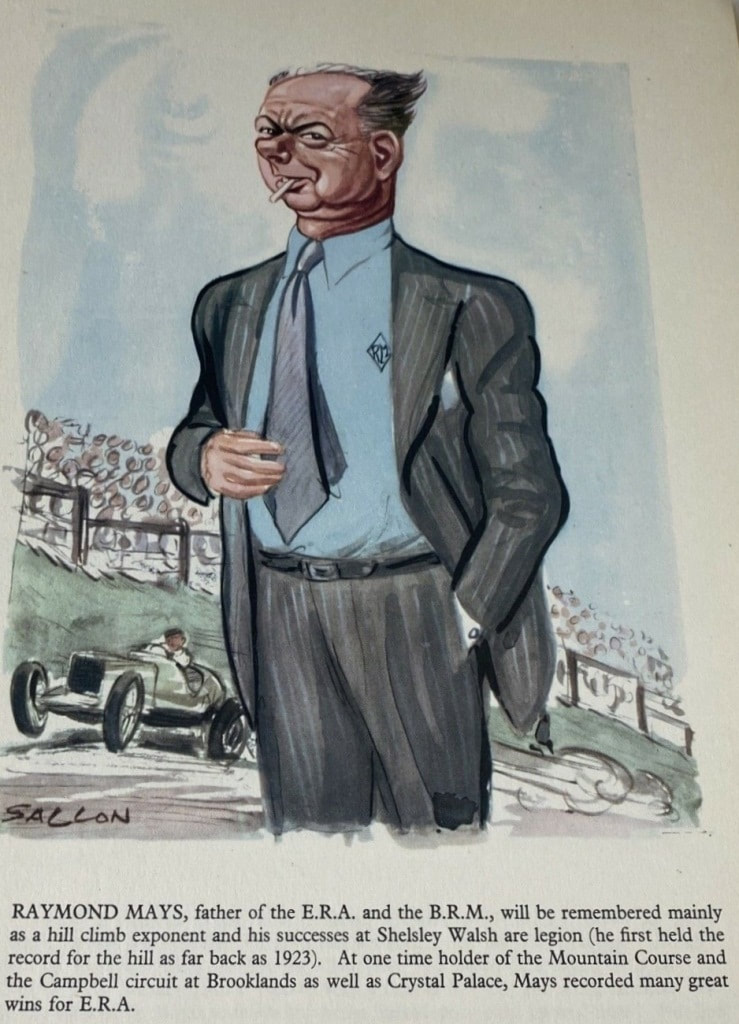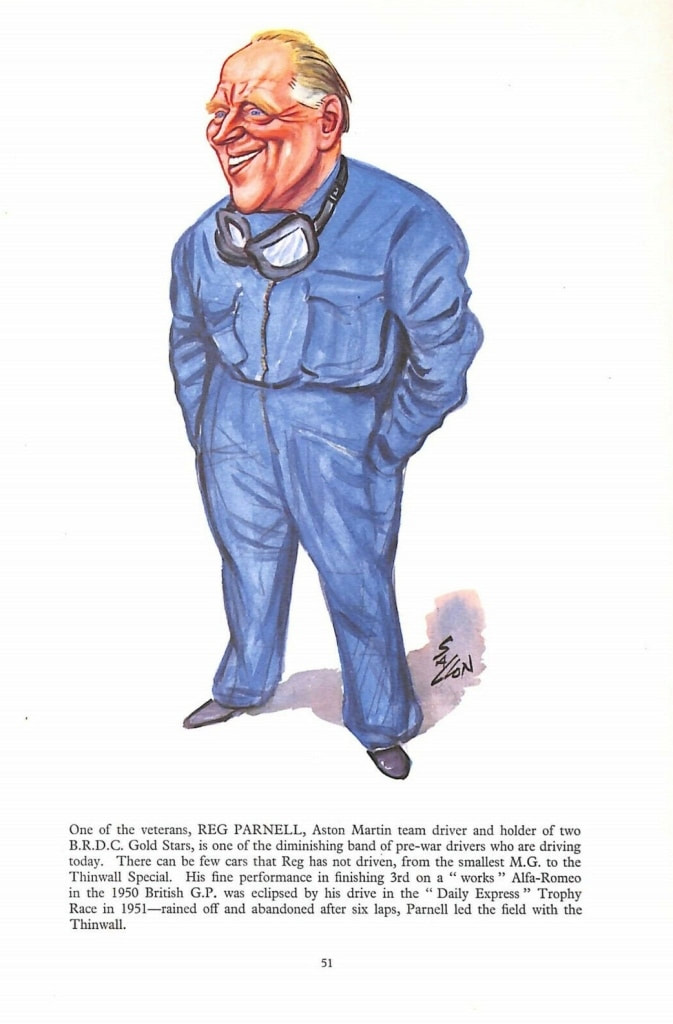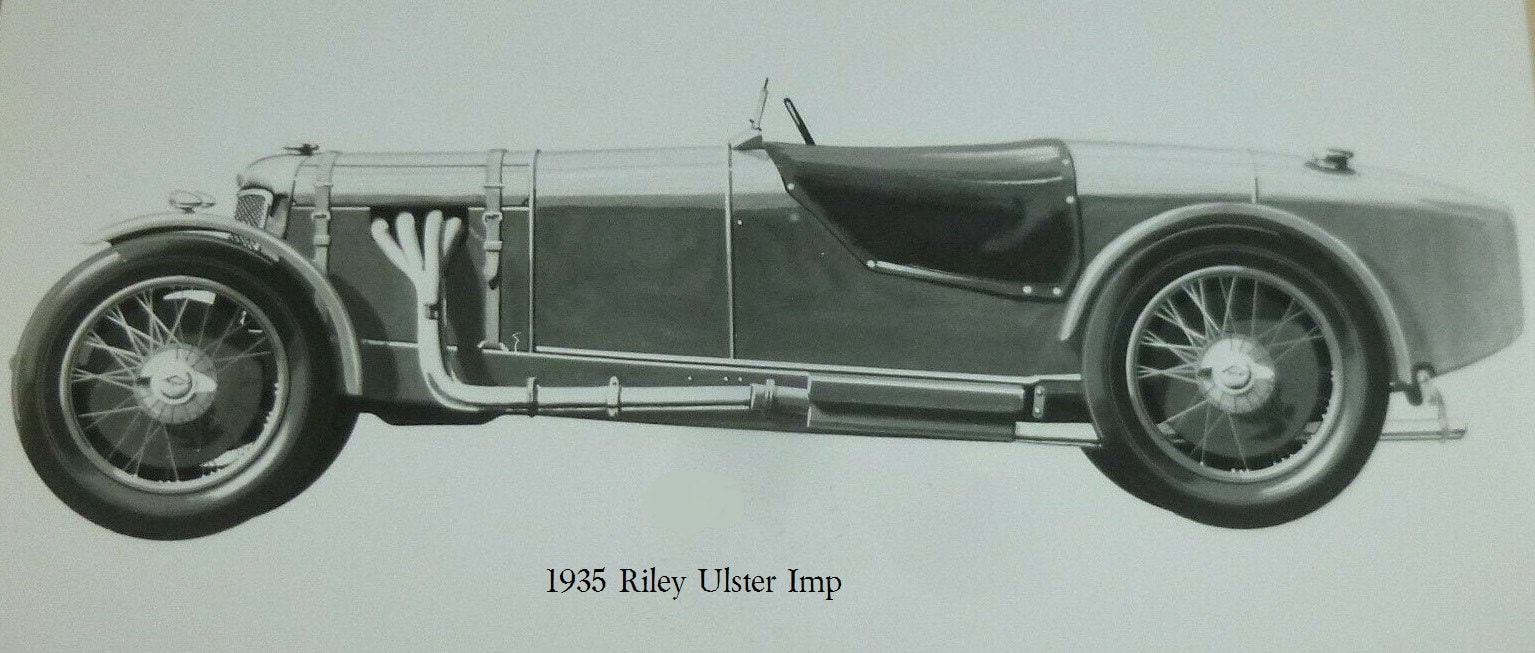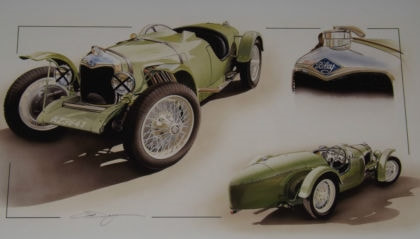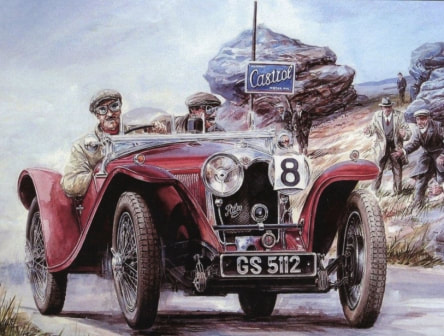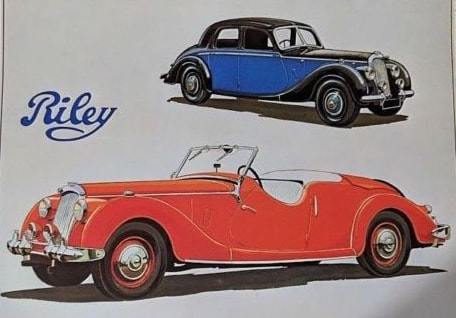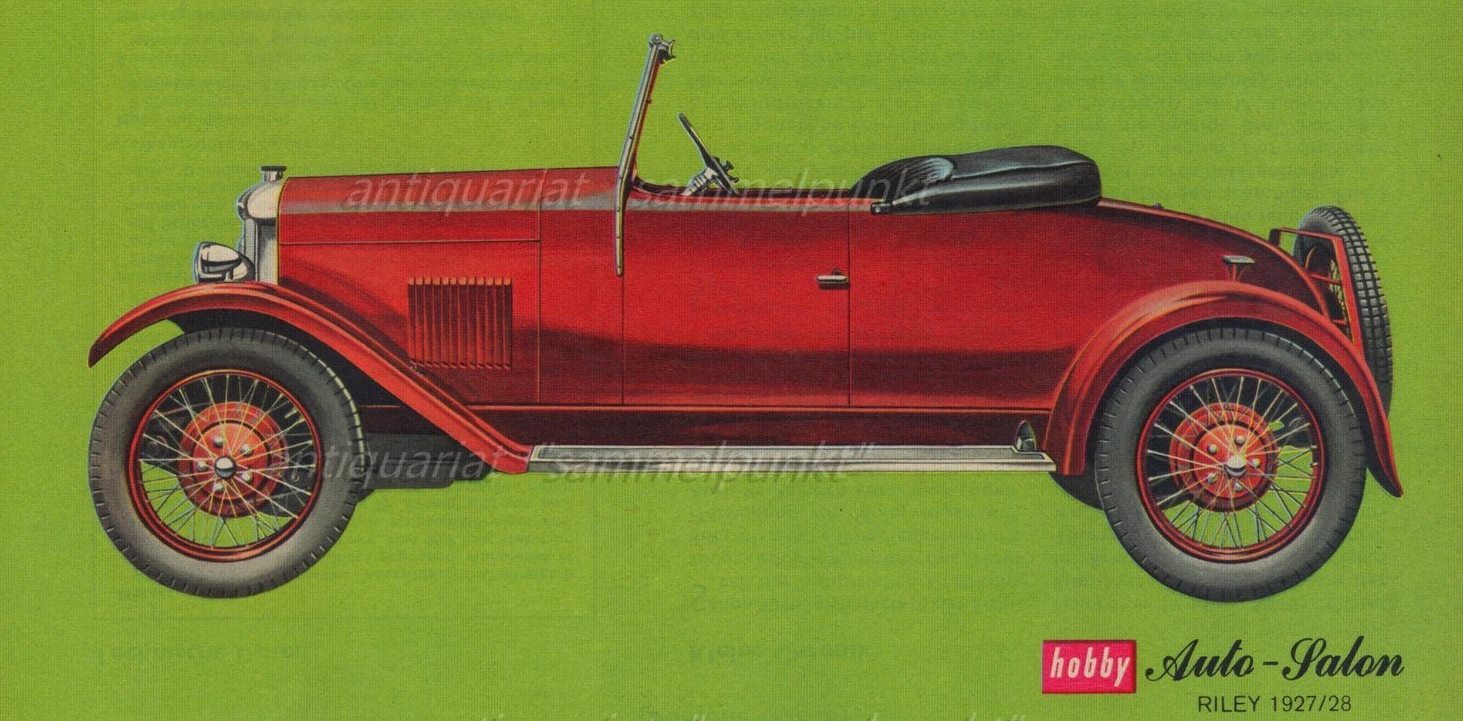Prints and Plates
Prints and Plates from books and other sources.
Below - Kenneth W Burton. Ken's website here - www.kenburton.co.uk/ , Born in Cambridgeshire in 1946, his interests in art began at school, leading to an initial choice of career in design and engraving.
In 1987 he settled down to his real vocation - of capturing the beauty of the countryside and old cars in watercolour.
Each of these 4 prints was limited to 850 copies worldwide (no longer on Ken's website).
Below - Riley Imp 1934 and Riley Falcon 1935, Riley Lynx 1935 and Riley Falcon 1936,
Riley Monaco 1933 and Riley sprite 1933.
Below - A Hugh Evelyn print drawn by George A Oliver showing a 1930 Riley 9 "Brooklands" Maximum speed 80 mph approx; fuel consumption 30-35 mpg; 50 bhp. Price £420 approx.
Below - This print issued as a promotional item by the German petroleum company Aral.
The translated text on the back says :- The Riley "Brooklands" 1929, 1098 cc four cylinder sports car.
Riley cars were first built in Coventry, it was in the 1920's that the sport and racing cars became famous.
In 1932 they developed a 1468 cc version with 95.5 mm stroke and 57.2 mm bore, with 6 Amal carburettors these developed 96hp running at 5,600 rpm and 190km/h.
At the end of 1938 Riley was integrated into the well known Nuffield Group (British Motor Corporation).
The translated text on the back says :- The Riley "Brooklands" 1929, 1098 cc four cylinder sports car.
Riley cars were first built in Coventry, it was in the 1920's that the sport and racing cars became famous.
In 1932 they developed a 1468 cc version with 95.5 mm stroke and 57.2 mm bore, with 6 Amal carburettors these developed 96hp running at 5,600 rpm and 190km/h.
At the end of 1938 Riley was integrated into the well known Nuffield Group (British Motor Corporation).
Below - 2 prints from calendars, a 1904 804cc 6hp prototype, by David Styles and a 1934 "Nine"
Below - Riley owner Debra Wenlock is a member of the Guild of Motoring Artists who paints all manner of subjects but has a passion for cars and motoring - some examples shown including Debra in her own car, see her website (Riley's not always shown) for her whole range of paintings, prints and cards www.debrawenlock.co.uk/
Below - Prints from a 1956 book by the caricaturist Ralph Sallon, produced by Shell-Mex and BP to mark the 60th anniversary of the British Motor Industry. There are 68 prints 12" high X 10"wide, the ones shown all have a connection to Riley, some via ERA because of their use of Riley engines.
For information on some of these shown below click on their names which will take you to Wikipedia.
For information on some of these shown below click on their names which will take you to Wikipedia.
Above right - (B.Bira) en.wikipedia.org/wiki/Birabongse_Bhanudej
Below - en.wikipedia.org/wiki/Billy_Cotton ,en.wikipedia.org/wiki/Sammy_Davis_(racing_driver) ,en.wikipedia.org/wiki/Freddie_Dixon ,en.wikipedia.org/wiki/George_Eyston
Below - en.wikipedia.org/wiki/Billy_Cotton ,en.wikipedia.org/wiki/Sammy_Davis_(racing_driver) ,en.wikipedia.org/wiki/Freddie_Dixon ,en.wikipedia.org/wiki/George_Eyston
Below - - en.wikipedia.org/wiki/Bob_Gerard , en.wikipedia.org/wiki/Mike_Hawthorn , en.wikipedia.org/wiki/Raymond_Mays , en.wikipedia.org/wiki/Reg_Parnell
Below - en.wikipedia.org/wiki/Kay_Petre , Bob Porter , en.wikipedia.org/wiki/Whitney_Straight , en.wikipedia.org/wiki/Elsie_Mary_Wisdom
Below - Frederick Gordon Crosby
Frederick Gordon Crosby (1885-1943) was the greatest motoring artist of the classic car era.
His drawings and paintings capture the excitement and romance of motor racing’s golden years,
when the car industry was developing. He worked for Autocar magazine for most of his life.
For more on this talented artist go to - en.wikipedia.org/wiki/Frederick_Gordon_Crosby
Frederick Gordon Crosby (1885-1943) was the greatest motoring artist of the classic car era.
His drawings and paintings capture the excitement and romance of motor racing’s golden years,
when the car industry was developing. He worked for Autocar magazine for most of his life.
For more on this talented artist go to - en.wikipedia.org/wiki/Frederick_Gordon_Crosby
Below - Winner 1935 RAC Tourist Trophy Race on the Ards circuit, painting shows Freddie Dixon passing the Central Bar, (now the Elk Inn) Dundonald
from a watercolour painting by Northern Ireland motoring artist "Mike (at time of writing this is on gallery 8) www.mikeautoart.com/ .
from a watercolour painting by Northern Ireland motoring artist "Mike (at time of writing this is on gallery 8) www.mikeautoart.com/ .
Below - "1909 Riley Vee - Twin 10 hp 2 Seater" print and an Imp print from a calendar.
Below - 1908 Riley Tourer 12/18
From "Vintage Motorcars" book 1970.'Old Midnight' was what the employees at the Riley Cycle Company of Coventry christened their prototype 12-18hp model, introduced at the 1907 Olympia Exhibition, because its development had entailed so much overtime working. The 12-18 was designed by the brothers Percy and Stanley Riley, Percy had constructed his first motor car in 1896-8, having just left grammar school. He hand-filed the gears for this little voiturette himself, and fitted its single-cylinder engine with one of the earliest examples of a mechanically-operated inlet valve: most early cars breathed through automatic inlets, in which the suck of the piston pulled open the valve against the pressure of a light spring.
The 12-18 was the logical successor to Riley's first production four wheeler, the 9hp of 1906, which followed a line of tricars of more or less motor cycle type. Like the 9hp, the 12-18 had a vee-twin engine and a constant-mesh gearbox, with the ratios selected by dog-clutches. In an era when few drivers could change gear on a conventional gearbox without a horrendous 'sidegrubbing of teeth', the silence and ease of the Riley change met with a good deal of favourable comment. Novel, too, was the use of detachable wheels: most cars had fixed wheels, which meant that the frequent punctures had to be dealt with in situ. Riley used their own design of detachable wheels, which was subsequently adopted by a number of other manufacturers: the 9hp was said to have been the first car to feature detachable wheels as a standard item of equipment. The engine of the 12-18 had a bore of 102mm and a stroke of 127mm, giving a swept volume of 2113cc: it had a fairly effective system of pump-fed lubrication, fed from an oil tank under the bonnet. For its engine capacity, the 12-18 was no mean performer for its day: in May 1908 a four-seated example achieved 48mph over a flying kilometre on the private speed course on the Duke of Portland's estate at Welbeck Abbey, and a similar model won the Ballinaslaughter Hill Climb and made a virtual non-stop run in the Irish Reliability Trials of 1908. The 12-18 was available with either 'short' or 'long' chassis. The former sold for 225 guineas in two-seater and 235 guineas in four-seater form, and had an 8ft wheelbase. The 'long' with a 9ft wheelbase, cost £283 with five-seated 'rotund' coachwork. With their ovoid radiator and well-designed bodywork, the 12-18 Riley and its smaller sibling, the 10hp, introduced for 1908, were among the more handsome light cars of their day, and really laid the foundations for Riley's reputation as makers of high-quality cars of moderate capacity. It is difficult to see in them the genesis of the successful and much-loved Riley Nine of 1927 - which did so much to establish the image of the high-performance, economical light car: but the same designers were responsible for the later model, too.
V-twin engine, 102mm by 127mm; 2075cc, 12.9hp; three-speed gearbox and reverse; HT magneto; semi-elliptic springs front and rear.
©1967 National Magazine Co. Ltd. Drawn exclusively for CAR by Peter Griffin from the original in the Herbert Art Gallery and Museum, Coventry.
From "Vintage Motorcars" book 1970.'Old Midnight' was what the employees at the Riley Cycle Company of Coventry christened their prototype 12-18hp model, introduced at the 1907 Olympia Exhibition, because its development had entailed so much overtime working. The 12-18 was designed by the brothers Percy and Stanley Riley, Percy had constructed his first motor car in 1896-8, having just left grammar school. He hand-filed the gears for this little voiturette himself, and fitted its single-cylinder engine with one of the earliest examples of a mechanically-operated inlet valve: most early cars breathed through automatic inlets, in which the suck of the piston pulled open the valve against the pressure of a light spring.
The 12-18 was the logical successor to Riley's first production four wheeler, the 9hp of 1906, which followed a line of tricars of more or less motor cycle type. Like the 9hp, the 12-18 had a vee-twin engine and a constant-mesh gearbox, with the ratios selected by dog-clutches. In an era when few drivers could change gear on a conventional gearbox without a horrendous 'sidegrubbing of teeth', the silence and ease of the Riley change met with a good deal of favourable comment. Novel, too, was the use of detachable wheels: most cars had fixed wheels, which meant that the frequent punctures had to be dealt with in situ. Riley used their own design of detachable wheels, which was subsequently adopted by a number of other manufacturers: the 9hp was said to have been the first car to feature detachable wheels as a standard item of equipment. The engine of the 12-18 had a bore of 102mm and a stroke of 127mm, giving a swept volume of 2113cc: it had a fairly effective system of pump-fed lubrication, fed from an oil tank under the bonnet. For its engine capacity, the 12-18 was no mean performer for its day: in May 1908 a four-seated example achieved 48mph over a flying kilometre on the private speed course on the Duke of Portland's estate at Welbeck Abbey, and a similar model won the Ballinaslaughter Hill Climb and made a virtual non-stop run in the Irish Reliability Trials of 1908. The 12-18 was available with either 'short' or 'long' chassis. The former sold for 225 guineas in two-seater and 235 guineas in four-seater form, and had an 8ft wheelbase. The 'long' with a 9ft wheelbase, cost £283 with five-seated 'rotund' coachwork. With their ovoid radiator and well-designed bodywork, the 12-18 Riley and its smaller sibling, the 10hp, introduced for 1908, were among the more handsome light cars of their day, and really laid the foundations for Riley's reputation as makers of high-quality cars of moderate capacity. It is difficult to see in them the genesis of the successful and much-loved Riley Nine of 1927 - which did so much to establish the image of the high-performance, economical light car: but the same designers were responsible for the later model, too.
V-twin engine, 102mm by 127mm; 2075cc, 12.9hp; three-speed gearbox and reverse; HT magneto; semi-elliptic springs front and rear.
©1967 National Magazine Co. Ltd. Drawn exclusively for CAR by Peter Griffin from the original in the Herbert Art Gallery and Museum, Coventry.
Below - Parsons Parsonloid Products Technical Information Sheet 25 Riley 9 Brooklands, information is printed on the back and right - a nice black and white print of a1935 ulster Imp.
Below - from Cars of the World in colour , a series of 7 books from Blandford press published between 1969 and 1975.
Below - 2 x plates per page for each of the 5 Riley's and 1Autovia to feature in these books. An unusual volume order, vol. 1 sports cars 1928-1939, vol. 2 passenger cars 1863-1904, vol. 3 sports cars 1907-1927, vol. 4 passenger cars 1905-12, vol. 5 racing cars 1898-1921, vol. 6 passenger cars 1913-23 and vol. 7 passenger cars 1924-1942.
Below - Riley Brooklands is available as a limited edition print by the artist Chris Dugan from "The Motoring Man" 20 Hurn Road, Ringwood, Hants, BH24 2AF, Tel. 01425 479388, email motoring-man@hotmail.co.uk
Below - a cutout print from the comic "Eagle" February 1962 and a rather good 1936 Sprite print.
Below - A vintage rally scene by talented artist Vaclav Zapadlik, could not find a dedicate website but this one has some details - blackhawkcollection.com/project/vaclav-zapadlik-original-artwork/ and this one cs.wikipedia.org/wiki/V%C3%A1clav_Zapadl%C3%ADk which you may need to translate.
Below - A print of 2 RM's and a 1927/28 Riley print by Hobby, for sale on ebay.
Below - A nice black and white print of a cutaway 1933 Monaco saloon and 1934 MPH.
Below - Freddie Dixon white Riley print, and Freddie at Brooklands 1934
Below - print of a 4/72 advert and a 1935 Riley Imp
Below - a plate from The light car magazine may 1932


















